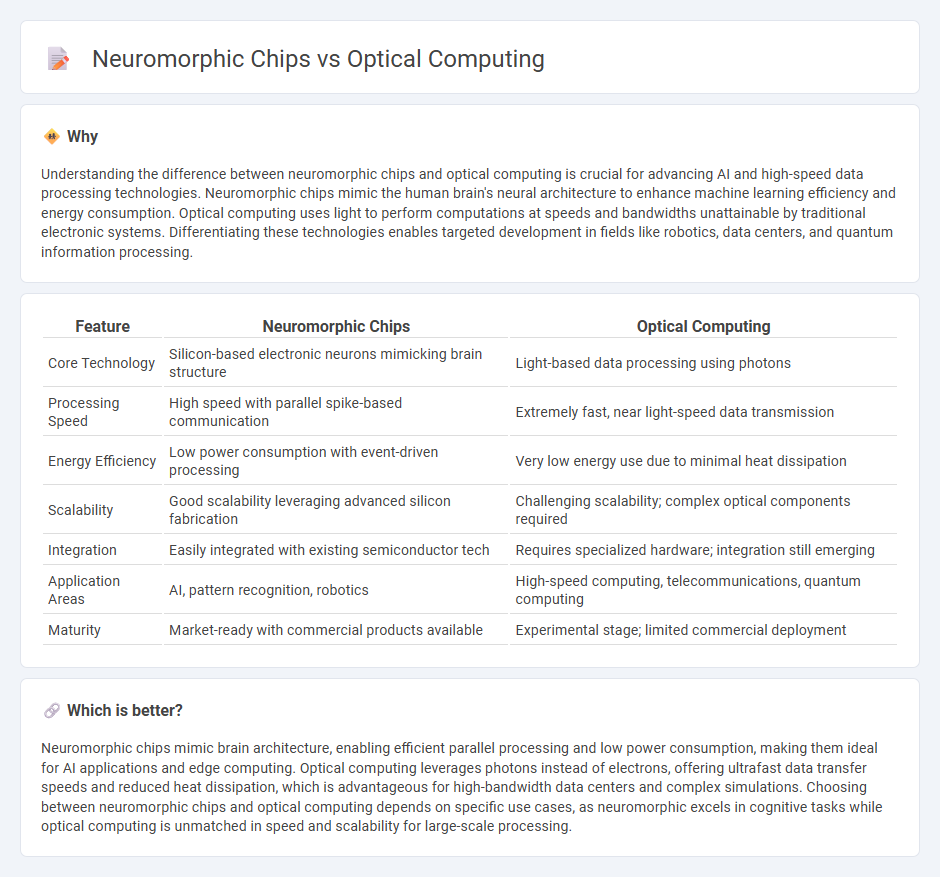
Neuromorphic chips mimic the human brain's neural architecture to enhance processing efficiency and enable advanced machine learning capabilities. Optical computing leverages photons instead of electrons, promising faster data transmission speeds and lower energy consumption for complex computations. Explore further to understand how these cutting-edge technologies are revolutionizing computational paradigms.
Why it is important
Understanding the difference between neuromorphic chips and optical computing is crucial for advancing AI and high-speed data processing technologies. Neuromorphic chips mimic the human brain's neural architecture to enhance machine learning efficiency and energy consumption. Optical computing uses light to perform computations at speeds and bandwidths unattainable by traditional electronic systems. Differentiating these technologies enables targeted development in fields like robotics, data centers, and quantum information processing.
Comparison Table
| Feature | Neuromorphic Chips | Optical Computing |
|---|---|---|
| Core Technology | Silicon-based electronic neurons mimicking brain structure | Light-based data processing using photons |
| Processing Speed | High speed with parallel spike-based communication | Extremely fast, near light-speed data transmission |
| Energy Efficiency | Low power consumption with event-driven processing | Very low energy use due to minimal heat dissipation |
| Scalability | Good scalability leveraging advanced silicon fabrication | Challenging scalability; complex optical components required |
| Integration | Easily integrated with existing semiconductor tech | Requires specialized hardware; integration still emerging |
| Application Areas | AI, pattern recognition, robotics | High-speed computing, telecommunications, quantum computing |
| Maturity | Market-ready with commercial products available | Experimental stage; limited commercial deployment |
Which is better?
Neuromorphic chips mimic brain architecture, enabling efficient parallel processing and low power consumption, making them ideal for AI applications and edge computing. Optical computing leverages photons instead of electrons, offering ultrafast data transfer speeds and reduced heat dissipation, which is advantageous for high-bandwidth data centers and complex simulations. Choosing between neuromorphic chips and optical computing depends on specific use cases, as neuromorphic excels in cognitive tasks while optical computing is unmatched in speed and scalability for large-scale processing.
Connection
Neuromorphic chips mimic the neural architecture of the human brain, enabling highly efficient parallel processing and low power consumption. Optical computing leverages photons instead of electrons to transmit and process data at the speed of light, offering unprecedented bandwidth and energy efficiency. Their connection lies in the potential for optical neuromorphic chips to combine brain-inspired architectures with ultra-fast, low-latency photonic hardware, revolutionizing artificial intelligence and edge computing applications.
Key Terms
Photonic circuits
Photonic circuits in optical computing leverage light to perform high-speed data transmission and processing, offering advantages in bandwidth and energy efficiency compared to traditional electronic systems. Neuromorphic chips use photonic circuits to mimic neural architectures, enabling advanced parallel processing and low-latency responses for AI applications. Explore the latest research to understand how photonic technologies are shaping the future of computing architectures.
Spiking neural networks
Optical computing leverages photons for high-speed data transmission and low energy consumption, enhancing the performance of Spiking Neural Networks (SNNs) by enabling ultra-fast spike propagation. Neuromorphic chips, designed to mimic the brain's architecture, use specialized electronic circuits to process spikes efficiently, supporting real-time learning and adaptive behavior in SNNs. Explore the latest research to understand how these technologies are revolutionizing the implementation of Spiking Neural Networks.
Synaptic transistors
Synaptic transistors play a crucial role in both optical computing and neuromorphic chips by mimicking biological synapses to enable efficient signal processing and low-power operation. Optical computing leverages photonic synaptic transistors to achieve ultrafast data transmission and parallel processing, while neuromorphic chips utilize electronic synaptic transistors to replicate neural network functions and improve learning capabilities. Discover how advancements in synaptic transistor technology are revolutionizing the future of computing.
Source and External Links
Optical computing - Wikipedia - Optical computing uses light waves produced by lasers or incoherent sources for data processing, storage, and communication, offering a potential for higher bandwidth than electronic computers, with research focused on integrating optical components to create optical-electronic hybrid systems or all-optical computers that reduce power consumption and conversion delays.
Optical Computing: Status and Perspectives - PMC - PubMed Central - Optical technology can vastly increase computational efficiency and speed, potentially processing data 100,000 times faster than current electronic computers, with advantages including resilience to electromagnetic interference, wide bandwidth, and massively parallel processing capabilities.
Optical computing: the power of light - TechHQ - Optical computers perform digital computations using photons via optical processors, data transfer, and storage, offering benefits such as high speed, low heat, immunity to electrical interference, and high storage density, though challenges include photonic material development and current prototype size.
 dowidth.com
dowidth.com